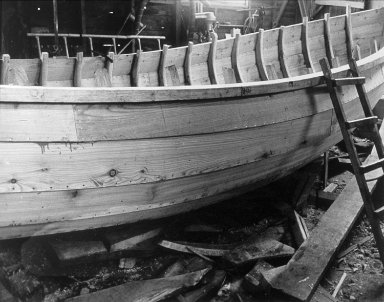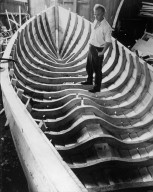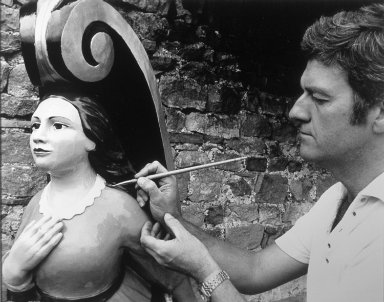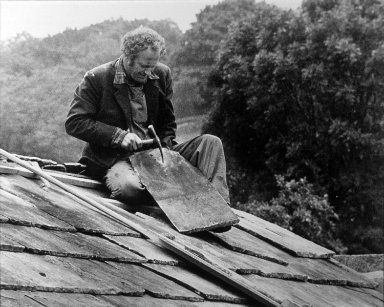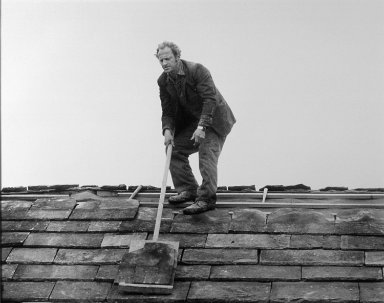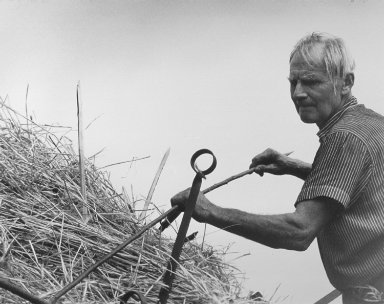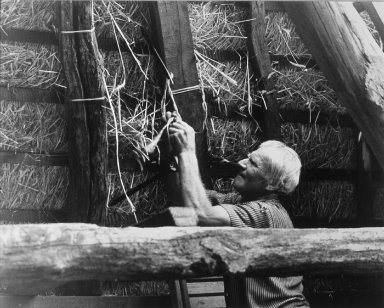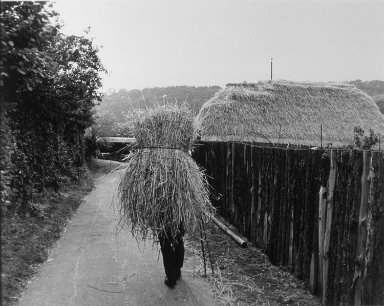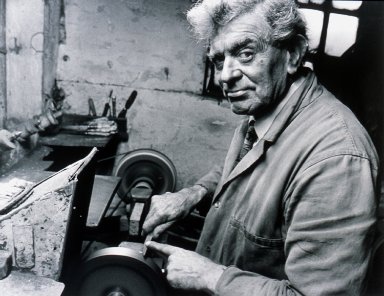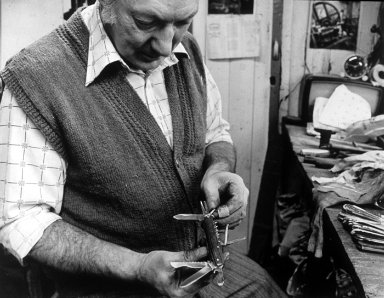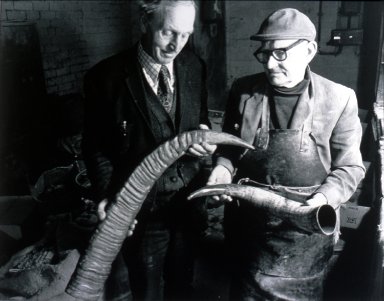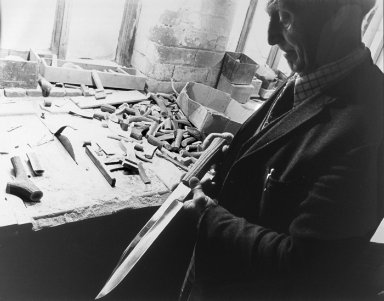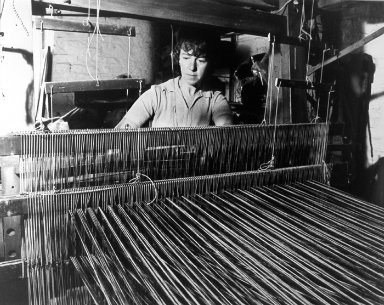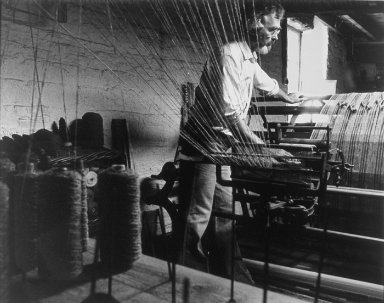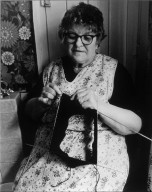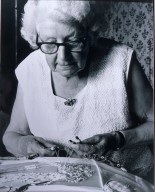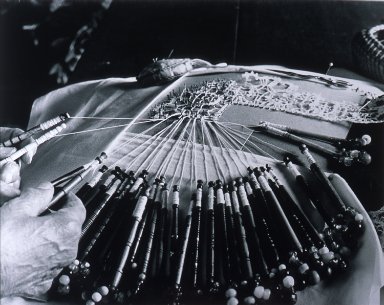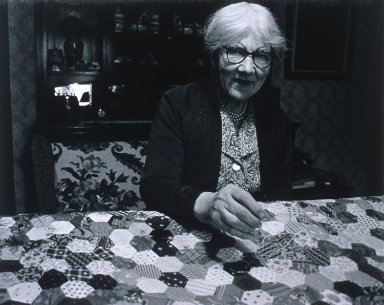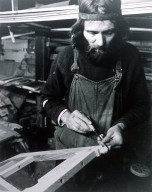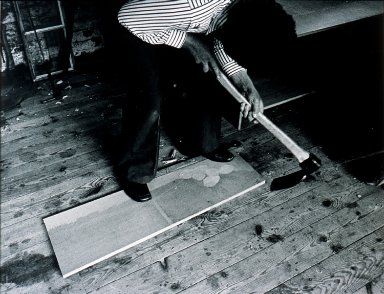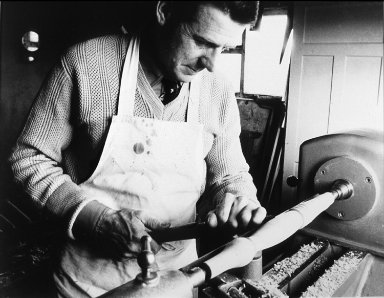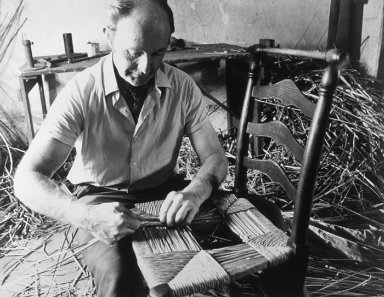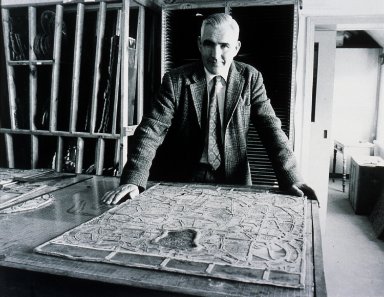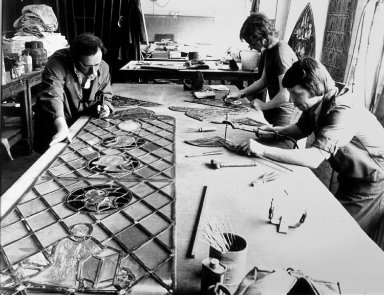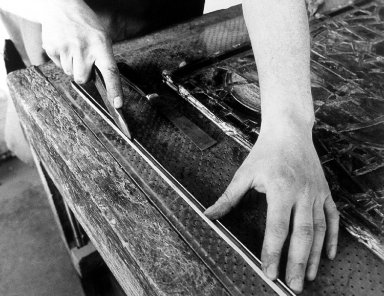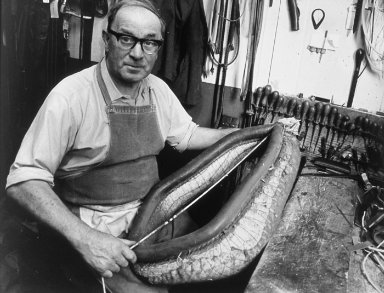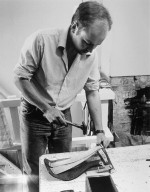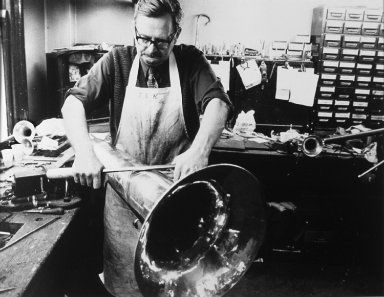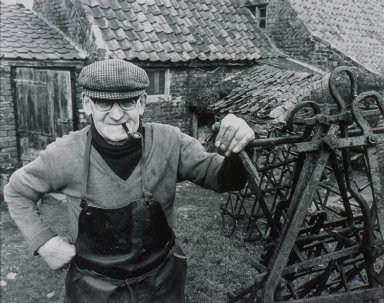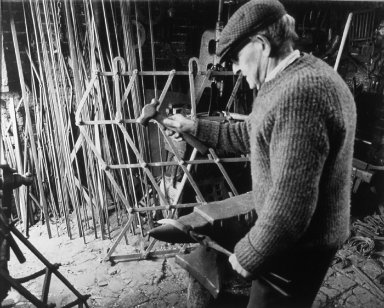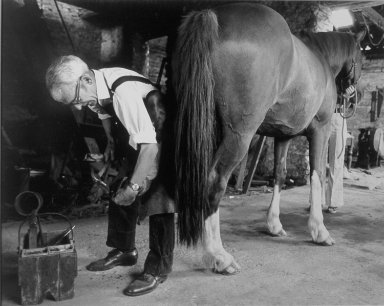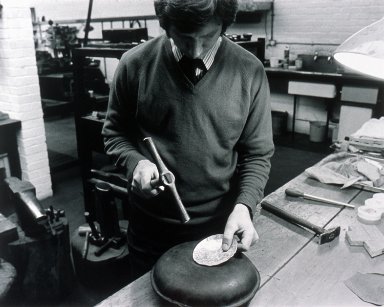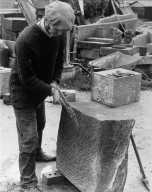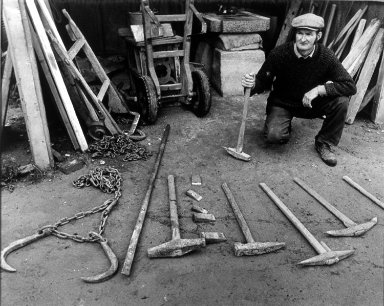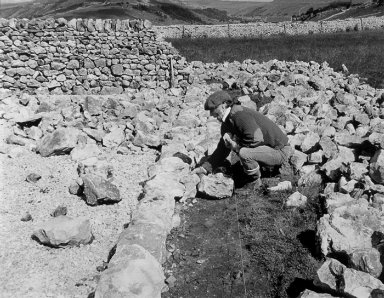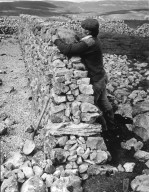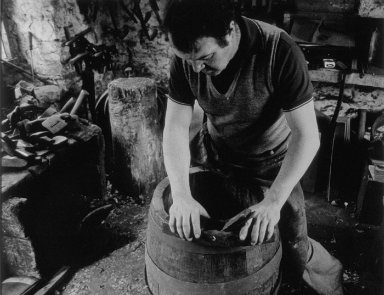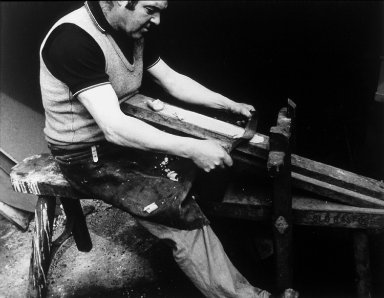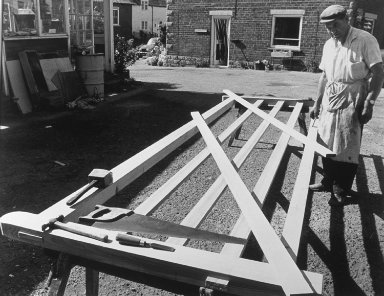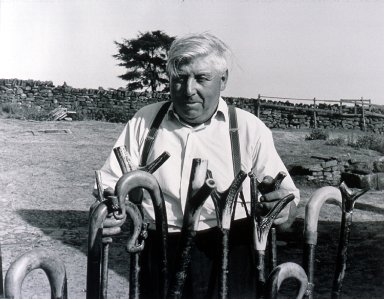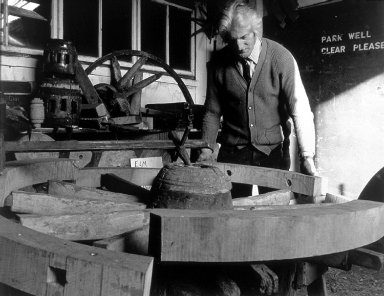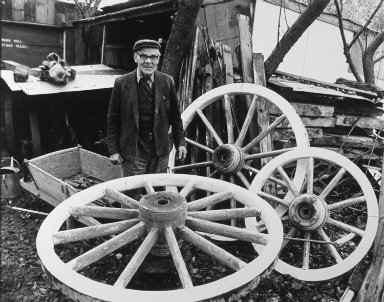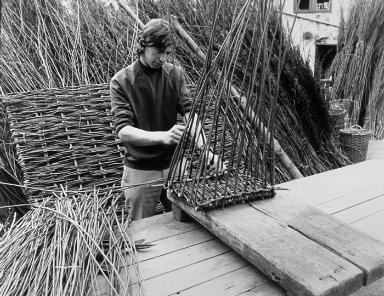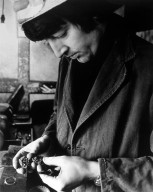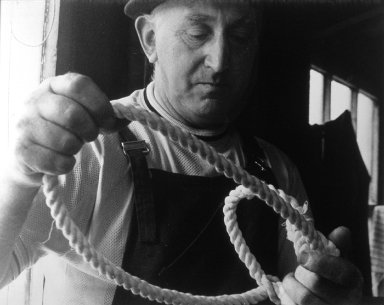|
Caption
The coble used to be the mainstay of the inshore fishing industry off Yorkshire's north-east coast. A coble is built from experience, from knowing exactly what the fisherman wants. There is no such thing as a set of plans. A coble is clinker-built. This means the external planks overlap each other and are fastened together with clinched copper nails.
Display Creator
REES, David Morgan
Creation Date
1970's
Location
Yorkshire
Caption
Billy Clarkson of Whitby looking at the shape and form of a coble during construction. The boat's design makes for maximum seaworthiness.
Display Creator
REES, David Morgan
Creation Date
1970's
Location
Yorkshire
Caption
Trevor Ellis carved and painted a series of ship's figureheads from pine in the small Coverdale village of Horsehouses. He supplied these to yaht clubs throughout Britain.
Display Creator
REES, David Morgan
Creation Date
1970's
Location
Yorkshire
Caption
Figure heads have been in use on ships since pre-Christian times. Here Trevor Ellis shapes a new figurehead.
Display Creator
REES, David Morgan
Creation Date
1970's
Location
Yorkshire
Caption
Yorkshire dales villages have a solidarity and visual unity which has been dictated by the materials available locally. Stone masons were content to repeat their simple methods in traditional materials because they knew they were good and proof against the savagery of the Northern elements. Bob Guy of the Reeth builders, Blenkiron & Co. using a slater's hammer to cut a stone roof slate to size.
Display Creator
REES, David Morgan
Creation Date
1970's
Location
Yorkshire
Caption
The old method of fixing roof slates was with wood pegs. Today alloy nails are used.
Display Creator
REES, David Morgan
Creation Date
1970's
Location
Yorkshire
Caption
Before stone or slate or tile, thatch was the universal roof covering throughout Yorkshire. Sometimes on an old cottage you may see the ghostly traces of the former type of roof. The pitch of a thatched roof has to be much steeper to allow the rain to flow off quickly. A 'spit' of hazel secures the 'yealmes' of straw and iron bodkins stitch the straw to the frame of the roof with twine.
Display Creator
REES, David Morgan
Creation Date
1970's
Location
Yorkshire
Caption
Seth Eccles of Helmsley working with thatch in the traditional way.
Display Creator
REES, David Morgan
Creation Date
1970's
Location
Yorkshire
Caption
A thatcher carrying his materials in the traditional way.
Display Creator
REES, David Morgan
Creation Date
1970's
Location
Yorkshire
Caption
The 'little mesters' who still exist in Sheffield with surprising resilience, despite the formidable difficulties facing the cutlery trade because of fierce foriegn competition, are the successors of workers in Nineteenth century independent cottage industries. The Grinders in the Sheffield cutlery trade form an important bridge between the hand blade forgers and the cutlers who fit the knives together. There is still constant demand for the specialised item, for that extra quality of craftsmanship.
Display Creator
REES, David Morgan
Creation Date
1970's
Location
Yorkshire
Caption
Close-up of a fully equipped penknife with each of the tools being hand made by Eric Wragg before the knife is assembled.
Display Creator
REES, David Morgan
Creation Date
1970's
Location
Yorkshire
Caption
The horn trade grew alongside the cutlery trade in suplying it with material for knife handles and 'scales' or coverings for pen and pocket knives. English oxen and cattle would have provided Sheffield craftsmen with horn even in Chaucer's day. Bernard Whiting and Harry Scarlett, formerly of Rocking Street, Sheffield were the last of the industry's horn cutters in the city. Their raw materials would include two types of buffalo horn.
Display Creator
REES, David Morgan
Creation Date
1970's
Location
Yorkshire
Caption
Harry Scarlett holds a knife fitted with a deer horn handle
Display Creator
REES, David Morgan
Creation Date
1970's
Location
Yorkshire
Caption
Hand loom weaving has moved from being an integral part of the Yorkshire woollen industry to an activity which is pursued by dedicated amateurs as a pastime. Keith and Margaret Brier were survivors of the earlier domestic way of working. They worked from their home in Upperthong which was a typical setting for the cottage industry of the seventeenth and eighteenth centuries when whole families spun, wove and still farmed. Margaret Brier of Upperthong near Holmfirth at work on a tappit hand loom weaving a sample length of woollen cloth.
Display Creator
REES, David Morgan
Creation Date
1970's
Location
Yorkshire
Caption
Keith Brier preparing the warp on a warping frame for his hand loom.
Display Creator
REES, David Morgan
Creation Date
1970's
Location
Yorkshire
Caption
Woollen garments for sailors and fishermen came to replace sealskin clothing as seals became harder to obtain around the coast of Britain. The style and terminology for these knitted garments seems to have originated in the Channel Islands. "Ganseys" or "guernseys" were customarily made from thick heavy dark blue wool, jerseys from lighter, thinner yarns and a wider variety of colours. Mrs Ethel Richardson of Old Whitby, a fisherman's wife, using the traditional four needles to knit a "gansey"
Display Creator
REES, David Morgan
Creation Date
1970's
Location
Yorkshire
Caption
Essentially a cottage industry to provide a little extra money for families, lacemaking has always been at the mercy of either fashion or competition from the Continent or from machines. Mrs Florence Longman of Wombleton near Helmsley making a 'pillow' lace.
Display Creator
REES, David Morgan
Creation Date
1970's
Location
Yorkshire
Caption
Close-up of the lace pattern as it develops on the 'pillow' with threads of linen yarn running from the bobbins to the pins holding the stitches in place. The complexity of the pattern is decided by the number of bobbins.
Display Creator
REES, David Morgan
Creation Date
1970's
Location
Yorkshire
Caption
Plain quilts consisting of sheets of whole cloth sandwiching an inner layer of wadding, with the decoration being provided by the stitching were popular in the Swaledale area of Yorkshire. It is thought to be a much earlier craft than the patchwork style which only emerged as more fanciful designs of woven textiles became more widely available. Miss Annie Pickard of Kirkbymoorside with her patchwork quilt containing over three thousand hexagonal patches of different print material, made on a wooden frame in her front parlour.
Display Creator
REES, David Morgan
Creation Date
1970's
Location
Yorkshire
Caption
The local furniture maker would be called upon to make all manner of things from farm implements to coffins. The majority of his customers would call on his skills for simple serviceable furniture, mainly in oak. The use of locally-grown materials, usually oak or ash or walnut has given a natural appearance to their work which was a result of sympathy with the wood itself as well as an understanding of the needs of the user.
Display Creator
REES, David Morgan
Creation Date
1970's
Location
Yorkshire
Caption
Using an adaze to fashion the surface of a piece of oak
Display Creator
REES, David Morgan
Creation Date
1970's
Location
Yorkshire
Caption
Wilf Hutchinson, furniture maker of Husthwaite North Yorkshire, putting his trade mark squirrel on an oak sideboard.
Display Creator
REES, David Morgan
Creation Date
1970's
Location
Yorkshire
Caption
Windsor chairs have been popular since the 18th Century and are usually fashioned from solid English wood. Brian Marlowe had a workshop high above Haworth where he designed and made a range of Windsor chairs using a lathe to turn the legs and back spindles.
Display Creator
REES, David Morgan
Creation Date
1970's
Location
Yorkshire
Caption
A craftsman at Taylor Brothers of Ulleskelf near Selby repairs a chair bottom using twisted and woven rushes.
Display Creator
REES, David Morgan
Creation Date
1970's
Location
Yorkshire
Caption
Of all the crafts that have existed since medieval times none can be as brilliant and unique as the work carried out by medieval glass painters. York today has the largest accumulated collection of ancient stained and painted glass in England. Peter Gibson of the York Glazier's trust had prime responsibility for preserving and restoring all the stained glass in York Minster and other buildings nationwide.
Display Creator
REES, David Morgan
Creation Date
1970's
Location
Yorkshire
Caption
Combining brilliance of beauty with reverence and mystery, the Minster is the work of scores of glazier craftsmen, most of whom were unknown. It is a complete visual commentary on glass painting over the last eight hundred years.
Display Creator
REES, David Morgan
Creation Date
1970's
Location
Yorkshire
Caption
A section of lead is opened out with a "lathekin" in preparation to receive the glass.
Display Creator
REES, David Morgan
Creation Date
1970's
Location
Yorkshire
Caption
Saddlery today is mostly concerned with repairs and miscellaneous leather work rather than with crafting new saddles. Saddlery for working horses on the land is a rare occurrence for a craftsman. Tom Thacker, a general saddler in the market town of Bedale, measures a leather horse collar
Display Creator
REES, David Morgan
Creation Date
1970's
Location
Yorkshire
Caption
As well as being the sport of kings, horse racing is meat and drink to many a Yorkshireman. The county abounds with race courses from the small and cosy like Thirsk to the large and hectic like York or Doncaster, home of the St Leger. Malcolm Hadfield, a self taught saddler near Malton making a saddle tree which is the frame on which the light-weight racing saddle is later built.
Display Creator
REES, David Morgan
Creation Date
1970's
Location
Yorkshire
Caption
Malcolm displays the component parts of a racing saddle. The racing saddler provides a standard of workmanship which must match the thoroughbred qualities of the animals wearing the gear he makes.
Display Creator
REES, David Morgan
Creation Date
1970's
Location
Yorkshire
Caption
Roy Wadman working on the bell of a tuba in the workshop of RS Kitchen Ltd which was founded in 1875 to repair the instruments of brass bands in the North of England. In the early Twentieth century many mills, collieries and factories supported their own brass bands.
Display Creator
REES, David Morgan
Creation Date
1970's
Location
Yorkshire
Caption
Because he made almost everything needed for the community for use in the home, on the land or to wage war, the blacksmith was regarded as the king among craftsmen. George Twiddle, a traditional country Blacksmith at Brigham near Driffield, pictured here standing outside his smithy, which is reputed to be well over 250 years old, with one of his farrows.
Display Creator
REES, David Morgan
Creation Date
1970's
Location
Yorkshire
Caption
George Twiddle at work on his single ended anvil in his small crowded smithy.
Display Creator
REES, David Morgan
Creation Date
1970's
Location
Yorkshire
Caption
Men who specialised in the shoeing of horses were called farriers, derived from the Latin 'faber farrarius' or 'one skilled in iron work. The blacksmith was the worker in iron, smithing or 'smiting' implements and iron work generally, the farrier made the shoes and shod the horses, whether for working on the land or for riding and hunting. Phil Dowson, the fourth generation of a Kirkbymoorside family to work as a farrier in the Rydale forge, here seen nailing a hind shoe
Display Creator
REES, David Morgan
Creation Date
1970's
Location
Yorkshire
Caption
Silver production in Sheffield was of the mass produced, poorly designed, but profitable variety until the end of the 19th century. Under the influence of a number of Silversmiths trained at the Sheffield School of art a new, higher standard of work has developed, with the focus on craftsmanship and inspiration. Jack Spencer, a designer silversmith of Ecclesall Road, Sheffield, uses a double-ended hammer to 'block out' a disc of sterling silver on a silversmith's leather-covered sandbag as the first stage in hand-raising a silver goblet.
Display Creator
REES, David Morgan
Creation Date
1970's
Location
Yorkshire
Caption
Most stone masons seem to have experience of cutting stone in a quarry as well as patiently, lovingly fashioning it into a whole building, or a fireplace or a gravestone to stand in a country churchyard. Robert Wetherill, monumental and general stone mason at work on a piece of freestone, a type of sandstone, in his yard at Danby, Eskdale in the Cleveland hills.
Display Creator
REES, David Morgan
Creation Date
1970's
Location
Yorkshire
Caption
The principle tools of the stone mason's trade.
Display Creator
REES, David Morgan
Creation Date
1970's
Location
Yorkshire
Caption
Dry stone walling is one of the toughest and most basic of country crafts. Handed down from father to son the skill and hard work have preserved a dominant feature of the Yorkshire Dales Landscape. Geoff Lund at work on the foundation for a limestone wall on Wasser Hill above Conistone in Wharfdale.
Display Creator
REES, David Morgan
Creation Date
1970's
Location
Yorkshire
Caption
Geoff Lund, a waller since school, places a topstone to finish a section of wall.
Display Creator
REES, David Morgan
Creation Date
1970's
Location
Yorkshire
Caption
The cooper is one of the most highly skilled craftsmen in wood. While cabinet-makers and joiners work precisely to written measurements and drawings, the cooper by his skill, his sense of shape and form, will produce an article perfectly fitted for the job it has to do. The skill of the cooper lies in chiefly in making the staves. A cask is made from a number of staves or sections of wood, enclosing a circular head at either end and bound together with steel hops. Each stave has to be carefully shaped and bevelled with edges that are cut with the exact angle to form the tight-fitting circle of the belly of the cask
Display Creator
REES, David Morgan
Creation Date
1970's
Location
Yorkshire
Caption
Clive Hollis, cooper at Theakston's brewery, Masham, astride an old long jointer plane once used to shape the staves or sections of a wooden barrel before the introduction of powered machinery.
Display Creator
REES, David Morgan
Creation Date
1970's
Location
Yorkshire
Caption
The 'chimb' or cap hoop is positioned with a 'driver', a flat steel wedge
Display Creator
REES, David Morgan
Creation Date
1970's
Location
Yorkshire
Caption
John Harding, champion gate maker and winner of many prizes at Yorkshire shows. A well made gate in good quality timber and kept in good order is ultimately an economy and capable of saving time and temper.
Display Creator
REES, David Morgan
Creation Date
1970's
Location
Yorkshire
Caption
In the old days it was custom for farmers' sons to search the hedgerows for suitable material for making walking sticks, thumb ticks and Shepherds' crooks. Most country folk have developed this side-line into a profitable hobby by taking it to a fine craft. Fred Bentley of Gillamore, North Yorkshire with a variety of shepherd's crooks, walking sticks and thumb sticks which have been exhibited and sold at agricultural shows in the area.
Display Creator
REES, David Morgan
Creation Date
1970's
Location
Yorkshire
Caption
Generations of knowledge and custom evolved a basic design for wagons and carts that worked with simplicity and was capable of continual repair and renewal as parts wore out. In the larger villages farm carts and wagons were built by teams of craftsmen, but in many of the small Yorkshire villages it was more likely to be the village carpenter who would build the body and make the wheels himself. Cyril Sissons with a demonstration model to show how a wagon wheel is constructed with a central 'naff' or hub of elm, spokes of oak and felloes of ash.
Display Creator
REES, David Morgan
Creation Date
1970's
Location
Yorkshire
Caption
Percy Sissons with an East Yorkshire farm wagon made by the Sissons family at Beswick around 1890
Display Creator
REES, David Morgan
Creation Date
1970's
Location
Yorkshire
Caption
Percy Sissons, in his eighties. A man of many wheels - and wagons.
Display Creator
REES, David Morgan
Creation Date
1970's
Location
Yorkshire
Caption
Basket making is one of the oldest crafts in existence and there is a direct continuity stretching back over the centuries to earlier primitive communities where baskets were essential to survival. John Taylor of Ulleskelf North Yorkshire makes a basket from willow grown on the family's land nearby.
Display Creator
REES, David Morgan
Creation Date
1970's
Location
Yorkshire
Caption
Said to be the oldest industry in that part of the North York Moors, jet working was active in the Bronze age and continued through the Roman occupation into the middle ages. Queen Victoria is usually given the credit for turning jet into a fashion craze after introducing it to her court, and after Prince Albert died in 1861 jet ornaments were worn as a token of the nation's mourning. Roy Jay, a craftsman apprenticed in a long tradition carves jet jewellery in his workshop above church street in Old Whitby.
Display Creator
REES, David Morgan
Creation Date
1970's
Location
Yorkshire
Caption
Small fibre rope-making businesses were as closely in touch with the needs of farmers as rope makers in ports were with those of a shipping or fishing industry still largely powered by sail. Changing patterns of demand as well as the growth of larger rope-making companies and the introduction of new, man-made materials into the industry in place of traditional natural fibres hastened the disappearance of the small country rope maker.
Display Creator
REES, David Morgan
Creation Date
1970's
Location
Yorkshire
|
